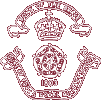


 |
 |
|
 |
||
| Navigation links at the bottom of this page |
|
Radio towers?
|
|
In the late spring of 1939, a crew of 'iron fighters' arrived at the
edge of the white cliffs of Dover and began erecting four steel towers.
The resulting structures were huge. They dominated the landscape. At
the time of construction, the school population, staff and boys, thought
they were witnessing the erection of repeater radio towers for the BBC.
In fact, they formed part of a chain of aircraft detection stations that
stretched as a chain on the east coast of the United Kingdom. To those
who organized the detection system under Sir Watson Watt, the acknowledge
inventor of British radar, the string of stations was known as the Chain
Home system, which is described in Winning the Radar War (1986)
pub. Macmillan of Canada.
By mid-summer, 1939, the Dover station at was erected and under test. No one outside the service responsible for operating it had any inkling of its purpose. Secret the system was perhaps, but four sky-scraper steel towers were there for everyone to see. Even German youth groups busily cycling from one end of the country to the other snapping holiday their shots in the years before World War Two were unaware of their purpose. Oddly enough, there is no record that these scouting groups ever photographed the C-H towers though they may have done. In 1938, the German high command brought a Zeppelin out of mothballs, fitted it with a mass of radio sensing equipment and sent it to cruise off the coast of the United Kingdom in search of evidence that any aircraft locating system similar to their own. The Zeppelin found none, but it did detect a massive and persistent noise in the 50-cycle wavelength that interfered with their radio-listening equipment and made sophisticated detection impossible. Knowing that the British power grid operated at 50 cycles per sec (CPS), the German listeners put the interference of their equipment down to lousy cable joints and loose connections. The British C-H system was safe. Unknown to British, the Germans developed their own system of aircraft detection about the same time that Watson-Watt and his team were working things out at Bawdsey Manor on the Suffolk coast. The German system operated at a high frequency. It produced a stiletto-like beam, but its range was short, no more than with a 15 mile range at the start. Unknown to the Luftwaffe Chief of Radio Telecommunications General Wolfgang Martini, the British had developed a radar system. It broadcast like a ghetto blaster at such strength and volume that its waves were detected as far away as New Jersey in the United States. This is what the Zeppelin listeners detected on their equipment, but ignored. Still unsure of themselves in the final months before the war, German Telecommunications Command made one more effort to check for British radar. They despatched the Zeppelin across the North Sea again, just to make sure. By the time of the second visit, the C-H system was in place and operational. The Zeppelin eavesdroppers returned to repeat their 1938 report: no detection system; inefficient national grid; huge radio interference in the 50 cycle range. Following the fall of France in 1940, the Germans could stand on the
white cliffs of France and gaze across the Channel, which they did. With
advanced photographic equipment, they took an exposure of the Dover station
towers with "...a five minute exposure on an infra-red camera at
a distance of 22 miles" as recorded in the caption accompanying
a reprint of the Dover station towers image in The definite story
of the Battle of Britain – The Narrow Margin (1961) published by
Arrow books of London. |
| The same radar towers as seen in 2005 from the Deal gate of the school. A number of changes have taken place since 1940 when the infra-red view of the towers was taken. Only three towers remain. What happened to the fourth is not known. There is a rational explanation for the change in the profile of the towers. That is the disappearance of the centre and topmost cross frame on each unit like the yard arms of a man o'war. |
| ||||||||||
|
© A. W. Cockerill 2011 Site Map Contact me | ||||||||||